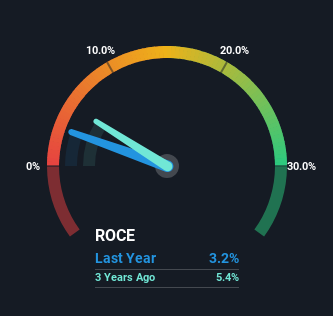Returns On Capital At Hong Leong Asia (SGX:H22) Paint A Concerning Picture
What financial metrics can indicate to us that a company is maturing or even in decline? Businesses in decline often have two underlying trends, firstly, a declining return on capital employed (ROCE) and a declining base of capital employed. This indicates to us that the business is not only shrinking the size of its net assets, but its returns are falling as well. And from a first read, things don't look too good at Hong Leong Asia (SGX:H22), so let's see why.
Understanding Return On Capital Employed (ROCE)
Just to clarify if you're unsure, ROCE is a metric for evaluating how much pre-tax income (in percentage terms) a company earns on the capital invested in its business. Analysts use this formula to calculate it for Hong Leong Asia:
Return on Capital Employed = Earnings Before Interest and Tax (EBIT) ÷ (Total Assets - Current Liabilities)
0.032 = S$96m ÷ (S$5.5b - S$2.6b) (Based on the trailing twelve months to December 2023).
So, Hong Leong Asia has an ROCE of 3.2%. Ultimately, that's a low return and it under-performs the Machinery industry average of 6.9%.
See our latest analysis for Hong Leong Asia
In the above chart we have measured Hong Leong Asia's prior ROCE against its prior performance, but the future is arguably more important. If you'd like to see what analysts are forecasting going forward, you should check out our free analyst report for Hong Leong Asia .
What Does the ROCE Trend For Hong Leong Asia Tell Us?
We are a bit worried about the trend of returns on capital at Hong Leong Asia. To be more specific, the ROCE was 7.3% five years ago, but since then it has dropped noticeably. On top of that, it's worth noting that the amount of capital employed within the business has remained relatively steady. This combination can be indicative of a mature business that still has areas to deploy capital, but the returns received aren't as high due potentially to new competition or smaller margins. So because these trends aren't typically conducive to creating a multi-bagger, we wouldn't hold our breath on Hong Leong Asia becoming one if things continue as they have.
On a side note, Hong Leong Asia's current liabilities are still rather high at 47% of total assets. This effectively means that suppliers (or short-term creditors) are funding a large portion of the business, so just be aware that this can introduce some elements of risk. Ideally we'd like to see this reduce as that would mean fewer obligations bearing risks.
Our Take On Hong Leong Asia's ROCE
In summary, it's unfortunate that Hong Leong Asia is generating lower returns from the same amount of capital. Despite the concerning underlying trends, the stock has actually gained 6.2% over the last five years, so it might be that the investors are expecting the trends to reverse. Regardless, we don't like the trends as they are and if they persist, we think you might find better investments elsewhere.
Hong Leong Asia does have some risks though, and we've spotted 1 warning sign for Hong Leong Asia that you might be interested in.
While Hong Leong Asia isn't earning the highest return, check out this free list of companies that are earning high returns on equity with solid balance sheets.
Have feedback on this article? Concerned about the content? Get in touch with us directly. Alternatively, email editorial-team (at) simplywallst.com.
This article by Simply Wall St is general in nature. We provide commentary based on historical data and analyst forecasts only using an unbiased methodology and our articles are not intended to be financial advice. It does not constitute a recommendation to buy or sell any stock, and does not take account of your objectives, or your financial situation. We aim to bring you long-term focused analysis driven by fundamental data. Note that our analysis may not factor in the latest price-sensitive company announcements or qualitative material. Simply Wall St has no position in any stocks mentioned.

